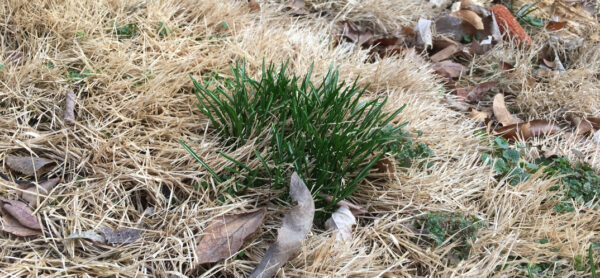By Sue Leahy
Member-at-Large and Chairperson, PR and Marketing Committee
Wild Ones – St. Louis Chapter
Several years ago my husband, Andy, and I planted a dense hedge of native shrubs and small trees in the fall at the back edge of our yard. When spring arrived, much to my dismay, up popped a huge crop of Star of Bethlehem (Ornithogalum umbellatum). This plant has leaves that look similar to crocus leaves, long and thin, with a beautiful star-shaped white flower. It is a member of the lily family and, like lilies, is toxic to humans and animals. This plant is native to Eastern Europe and the Middle East. It blooms in the spring and then dies back, not to be seen again until the next spring. While beautiful, it is also quite invasive and I didn’t want it in my hedge. The mulch and newspaper I had put down did nothing to keep these from coming up. The leaves just searched around until they found an opening.
The research I did indicated that Round-Up had only minimal effect on this plant and the recommended herbicide was D2,4. I’m not in favor of chemicals and that was just too toxic for my liking, especially with all my new trees and shrubs.
The alternative? Dig them up by hand! So, the two of us spent two solid weekends on our hands and knees gently scraping aside mulch and digging up these plants. You can’t pull them. The leaves come off and leave the little bulb behind to regenerate even more the next year. We frequently had to go down 8-12 inches to get at the bulb and often found clumps of bulbs. We had tilled the bed before planting and think we inadvertently spread these bulbs by doing so.
The following year I, alone, spent one weekend digging up plants we missed the previous year. By the third year, there was just an occasional plant here and there which were quickly dug up and disposed of.
A word of warning: don’t compost these bulbs or you will have Star of Bethlehem in everything. Send them away in the trash.
This was definitely one of the larger bumps in the road of my native gardening hobby!




This is a good activity for me to work on while I leave things intact in the rest of the yard. In the areas that I dug out last year, I am seeing improvement, just as Sue did. I know for some folks they are just too numerous to even think about tackling, but I don’t want them creeping into my beds, so I’m going to deal with the ugly holes by backfilling them and putting something back in there.
Thanks for sharing your stories. It helps to commiserate with fellow strugglers. This plant is pervasive in my yard. I’m focusing on my beds. No way can I tackle the “lawn” areas. Oh well. It gives me a reason to dig in the dirt in February.
Thank you for posting!! I have a “strip” of these growing in the area where our gutter drains in the backyard. They have never bloomed, that I’ve noticed. I did not realize until recently they were an invasive, as I’d admired them blooming in other’s yards, and thought the foliage so pretty and green. (Of course honeysuckle is pretty too, and we all know how that turned out!)
Many years ago I dug some of these up from a neighbor’s yard and moved them into mine. They were so pretty. Mine have never bloomed. I guess I am glad about that.
Even though they have not bloomed it seems the green bunch of leaves is spreading.
I guess I should remove them.